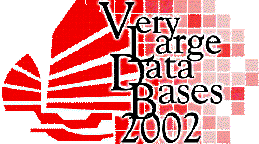|
Prepare your title and content sheets according to the
instructions given below. Send your title and contents
sheets, preferably as a PDF file (but we can also accept
PowerPoint or Word files) formatted for A4 size
paper, to vldb2002@cs.ust.hk.
The
submission deadline is 5:00 p.m. 15 July
2002.
We will print your title and
content sheets using a color printer and mount them on a
mounting board according to the poster
layouts shown
below.
|
|
There are two types of sheets in a poster:
- The title sheet
[t] includes the poster title, the name and
affiliation of the author, and, optionally, the name of
the supervisor. The title sheet has the following
parts:
|
1.1.
|
The title in at
least 24 pt (36 pt or 48 pt is better)
upper-case and lower-case letters.
|
|
1.2.
|
The author's
name and affiliation (organization name only
please) below the title in at least 18 pt (24 pt
or 30 pt is better) upper-case and lower-case
letters.
|
|
1.3.
|
Optionally, the
supervisor's name, in the format "Supervisor:
name", below the author's name in 18 pt
upper-case and lower-case letters.
|
You should use a large enough font size to be easy
visible from several meters (feet) away and that will
draw people to view your poster. Use all of the space on
the title sheet effectively; avoid leaving too much empty
space.
- The information
sheets [a1, a2, a3, a4, a5, a6] contain the
content of the poster. Note that you do not need
to use 6 sheets, but that is the maximum number of
content sheets you are allowed. You should design your
information layout according to the following
guidelines:
|
2.1.
|
The introductory
paragraphs should be in a larger typeface than
you use in a detailed descriptive section. The
typeface should be readable at a distance of two
to three meters (while the smallest type you use
may be readable at a distance of only one
meter). Generally speaking, keep in mind that
the larger and bolder your presentation, the
more enticing it will be to the people seeing it
at a distance. The real challenge then, after
you have attracted attention to your poster, is
to provide enough interesting and readable
detail for someone who wants to learn more. One
compromise might be to have some parts that are
packed with useful information and are typeset
in a smaller font. Don't forget, however, that
important results should be big enough for
reading at a reasonable distance!
|
|
2.2.
|
You should try
to use paragraphs with centered titles, such as
"Overview", and "Methodology" in at least 18 pt
upper-case and lower-case boldface
letters.
|
|
2.3.
|
Make effective
use of titles for paragraphs, figures and other
material. Use a typeface that is readable at two
to three meters (boldface helps) for the major
part of the titles (for visibility) and regular
type for details.
|
|
2.4.
|
A multicolumn
format usually improves readability by reducing
line length and allowing for more text
structuring.
|
|
2.5.
|
Color should be
used to effectively communicate what you want to
present (e.g., for emphasis, in graphs and other
graphics).
|
|
2.6.
|
Figures
(including diagrams, charts, graphs and
schematics) are a good way to communicate
interesting ideas.
|
Remember: posters are
supposed to be interactive. You will be there to
explain the details. Your poster should only convey the
most relevant points not all the fine detail of
your research.
|
